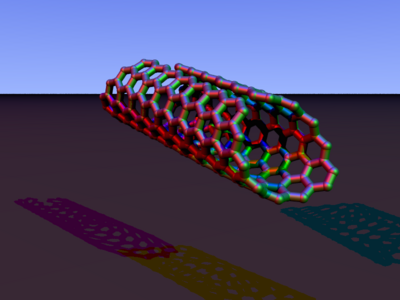Difference between revisions of "Advanced materials"
| (2 intermediate revisions by 2 users not shown) | |||
| Line 1: | Line 1: | ||
==Carbon fiber== | ==Carbon fiber== | ||
| − | |||
| − | [[Image:Carbon_fiber_lotus.jpg|thumb|350px|A carbon fiber car. Making cars out of carbon fiber instead of steel reduces the weight by hundreds of kilos, which represents a massive saving of [[energy]] usage. It also provides better safety in case of crashes.]] | + | [[Image:Carbon_fiber_lotus.jpg|thumb|350px|A carbon fiber car. Making cars out of carbon fiber instead of steel reduces the weight by hundreds of kilos, which represents a massive saving of [[energy]] usage. It also provides better safety in case of crashes.]]{{wp|Carbon_fiber-reinforced_polymer|Carbon fiber}} is a substance that is four times lighter than steel, yet five times stronger. It is currently about 14 times the price of steel, but this is entirely a result of [[scarcity]]-based market forces; the raw materials are cheap and abundant. Light, strong materials like carbon fiber are essential to [[Colonising Space|space travel]], better transport systems and a host of other applications. |
| + | |||
==Carbon nanotubes== | ==Carbon nanotubes== | ||
| − | |||
| − | |||
| − | They have a | + | Carbon nanotubes are a substance made from carbon atoms bound together like this: |
| + | [[Image:Carbon_nanotube.PNG|400px]] | ||
| + | |||
| + | These nanotubes have some extraordinary properties: | ||
| + | |||
| + | * They have enormous tensile strength {{en}} theoretically the greatest of any material known. | ||
| + | * A great capacity to conduct heat {{en}} theoretically better than any metal | ||
| + | * Fantastic electrical conductance {{en}} theoretically nanotubes, with their carbon lattice in the 'arm-chair' configuration, will conduct electricity far better than any metal, and additionally for a cable of the same resistance as an equivalent metal conductor, can take a much greater current density because of its thermal properties and capability to withstand very high temperatures. | ||
| + | * Other forms of carbon nanotube are electrical {{wp|semiconductor|semiconductors}} and could form the basis for molecular computing | ||
| + | |||
| + | Currently most of the properties mentioned above do not trounce existing materials yet due to the fact that nanotubes cannot be made very long yet, only of the order of millimetres. Although this is extremely long for a molecule, a cable made from nanotubes would have to have all of its constituent nanotubes run its full length in order for the cable to inherit these properties too. Making this possible is a holy grail of material science and the focus of much academic and commercial research today. | ||
| + | |||
| + | A cable the thickness of a human hair made using carbon nanotubes could theoretically hold up a car and carbon composites made from nanotubes could be many times thinner, lighter and stronger than they are already. An extreme example is the possibility of creating a [[Colonising Space/Access to space|space elevator]] using such cables stretching for tens of thousands of kilometres into space (all the way to {{wp|Geostationary_orbit|geostationary orbit}} and beyond), which may allow easier access to space than is possible with rockets for certain orbits. | ||
| − | + | Perhaps most importantly of all, they can be used as filters to purify and desalinate water as discussed [[Fundamental resources/Water|here]]. | |
Future uses of nanotubes may include providing the circuitry and motors for [[Advanced automation/Nanotechnology|nanotechnology]], in flywheels and capacitors to store [[Fundamental resources/Energy|electricity]] and in photovoltaics. However, even using only the applications that have been fully worked-out and realized, they have the capacity to change civilization. | Future uses of nanotubes may include providing the circuitry and motors for [[Advanced automation/Nanotechnology|nanotechnology]], in flywheels and capacitors to store [[Fundamental resources/Energy|electricity]] and in photovoltaics. However, even using only the applications that have been fully worked-out and realized, they have the capacity to change civilization. | ||
They are not particularly expensive, even in a [[scarcity]]-based economy. They are made from simple carbon, which is cheap and common. There are companies selling them for $3 a gram. If production were scaled up to mass-production, the price would go down even further. | They are not particularly expensive, even in a [[scarcity]]-based economy. They are made from simple carbon, which is cheap and common. There are companies selling them for $3 a gram. If production were scaled up to mass-production, the price would go down even further. | ||
Latest revision as of 23:42, 27 June 2010
Carbon fiber

 is a substance that is four times lighter than steel, yet five times stronger. It is currently about 14 times the price of steel, but this is entirely a result of scarcity-based market forces; the raw materials are cheap and abundant. Light, strong materials like carbon fiber are essential to space travel, better transport systems and a host of other applications.
is a substance that is four times lighter than steel, yet five times stronger. It is currently about 14 times the price of steel, but this is entirely a result of scarcity-based market forces; the raw materials are cheap and abundant. Light, strong materials like carbon fiber are essential to space travel, better transport systems and a host of other applications.
Carbon nanotubes
Carbon nanotubes are a substance made from carbon atoms bound together like this:

These nanotubes have some extraordinary properties:
- They have enormous tensile strength – theoretically the greatest of any material known.
- A great capacity to conduct heat – theoretically better than any metal
- Fantastic electrical conductance – theoretically nanotubes, with their carbon lattice in the 'arm-chair' configuration, will conduct electricity far better than any metal, and additionally for a cable of the same resistance as an equivalent metal conductor, can take a much greater current density because of its thermal properties and capability to withstand very high temperatures.
- Other forms of carbon nanotube are electrical semiconductors
 and could form the basis for molecular computing
and could form the basis for molecular computing
Currently most of the properties mentioned above do not trounce existing materials yet due to the fact that nanotubes cannot be made very long yet, only of the order of millimetres. Although this is extremely long for a molecule, a cable made from nanotubes would have to have all of its constituent nanotubes run its full length in order for the cable to inherit these properties too. Making this possible is a holy grail of material science and the focus of much academic and commercial research today.
A cable the thickness of a human hair made using carbon nanotubes could theoretically hold up a car and carbon composites made from nanotubes could be many times thinner, lighter and stronger than they are already. An extreme example is the possibility of creating a space elevator using such cables stretching for tens of thousands of kilometres into space (all the way to geostationary orbit  and beyond), which may allow easier access to space than is possible with rockets for certain orbits.
and beyond), which may allow easier access to space than is possible with rockets for certain orbits.
Perhaps most importantly of all, they can be used as filters to purify and desalinate water as discussed here.
Future uses of nanotubes may include providing the circuitry and motors for nanotechnology, in flywheels and capacitors to store electricity and in photovoltaics. However, even using only the applications that have been fully worked-out and realized, they have the capacity to change civilization.
They are not particularly expensive, even in a scarcity-based economy. They are made from simple carbon, which is cheap and common. There are companies selling them for $3 a gram. If production were scaled up to mass-production, the price would go down even further.